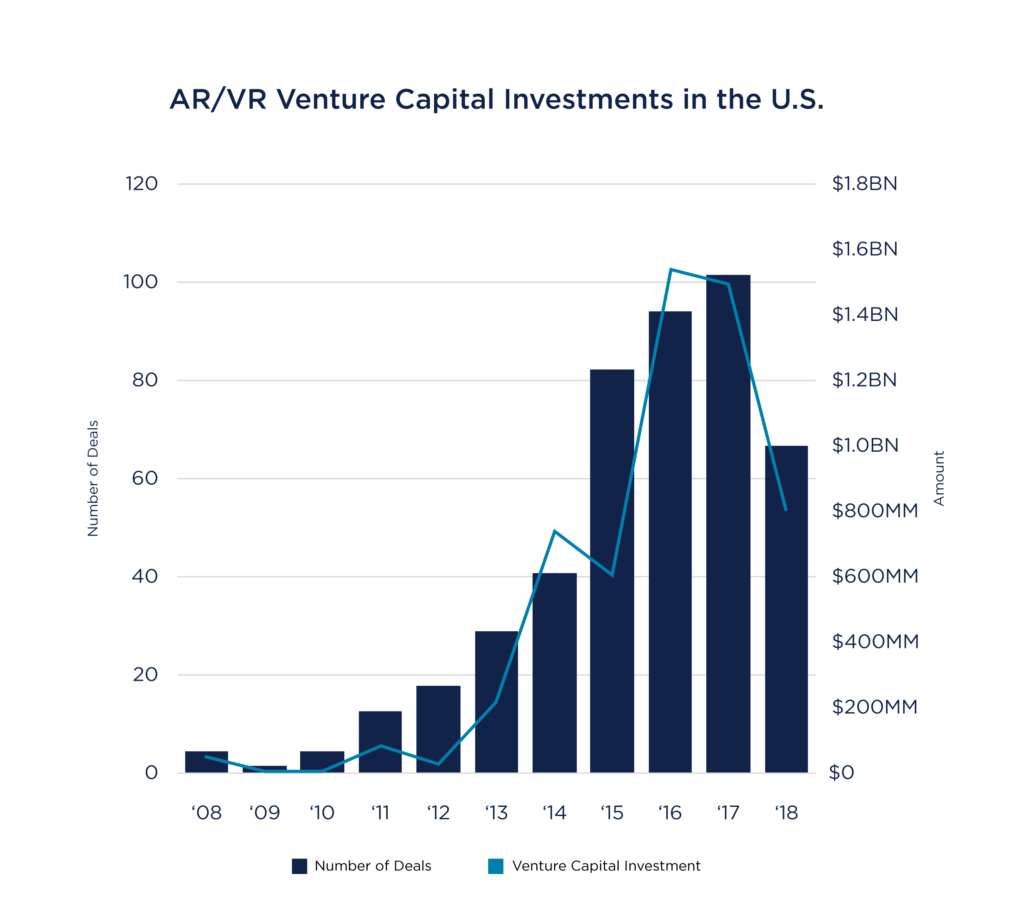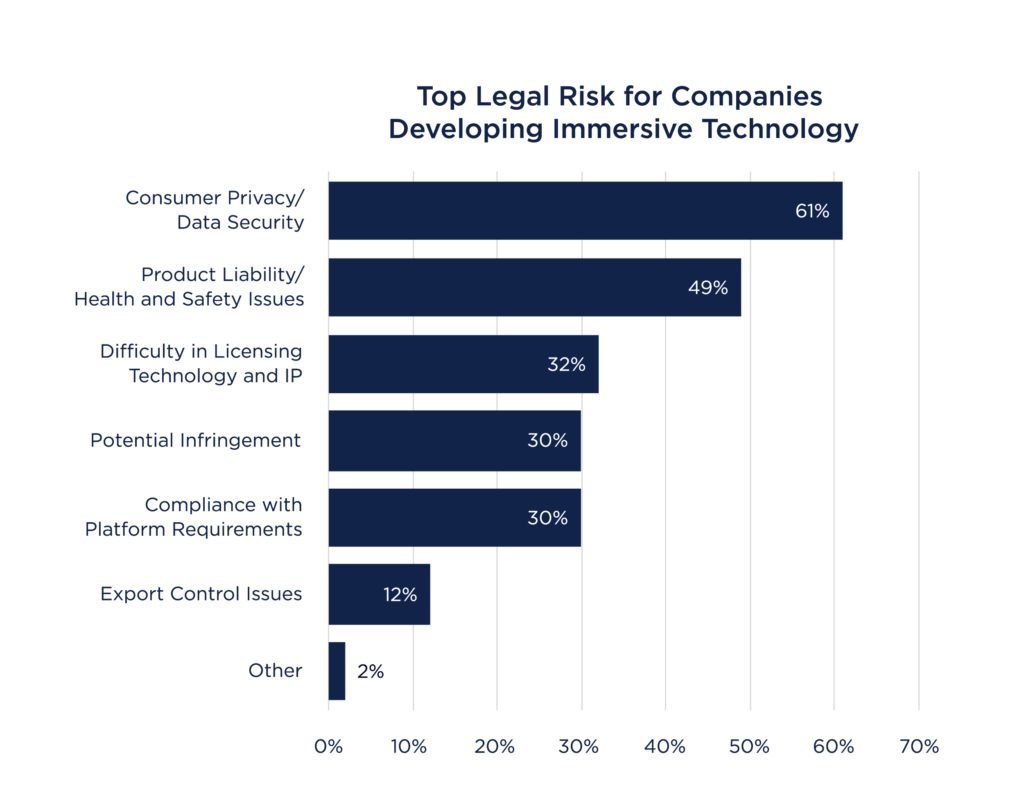An Introduction to Immersive Technologies
Definition and Types of Immersive Technology
Immersive technologies create distinct experiences by merging the physical world with a digital or simulated reality. Augmented reality (AR) and virtual reality (VR) are two principal types of immersive technologies. These technologies share many of the same qualities. However, AR blends computer-generated information onto the user’s real environment, while VR uses computer-generated information to provide a full sense of immersion.
Augmented Reality Overview
AR relies on processors, a display, sensors and input devices to create an experience. There are four types of AR:
- Marker-based AR uses a visual marker, like a QR code, to produce a result. For example, Snapchat uses marker-based AR to help its users add people to their contact lists.
- Markerless AR uses GPS or a digital compass, velocity meter or accelerometer to provide data. Google Maps Live View uses markerless AR to navigate users to their destination.
- Projection-based AR projects artificial light onto surfaces. For example, researchers at the Digital Nature Group used lasers, mirrors and cameras to create a hologram-like experience, which can be felt by the user.
- Superimposition partially or fully replaces the original view of an object with a new view. IKEA and GOAT are two companies taking advantage of this technology. IKEA allows users to preview furniture in their house on their smartphone, while GOAT enables users to use their smartphone to superimpose the latest sneakers on their feet.
Virtual Reality Overview
VR systems use head-mounted displays and input devices to provide a sense of immersion. Head-mounted displays cover the user’s field of view to display computer-generated content. Input devices such as joysticks, tracking balls, controller balls and data gloves allow the user to interact with the virtual environment. Just like AR, there are different types of VR for different use cases:
- In non-immersive VR, only a subset of a user’s senses is stimulated, allowing the user to maintain awareness of the physical environment outside of the virtual reality. For example, the HP Reverb Pro headset allows designers to create 3D models.
- Semi-immersive VR leverages more senses than non-immersive VR, but still does not take advantage of all senses. For example, flight simulation allows pilots to learn how to fly different aircrafts through realistic displays that simulate different in-flight experiences.
- Finally, fully-immersive VR stimulates all of the user’s senses. For example, Infinadeck has created an omnichannel treadmill that allows users to move within a virtual environment.
Immersive Technology Timeline
Early Stages: 1957 – 1991
1957: Immersive technology for recreational purposes was brought to the fore with the invention of Sensorama. This cinematic experience, developed by Morton Heilig, placed the viewer in a “sensory” theater that included speakers, fans, smell generators and a vibrating chair to immerse the viewer in the movie.
1968: The Sword of Damocles was the first VR head-mounted display connected to a computer rather than a camera. It is the blueprint for VR headsets seen today.
1991: Sega launched the Sega VR headset at the Consumer Electronics Show for arcades and home use. However, only the arcade version was released due to technical difficulties.
Growth: 1992 – 1999
1992: The development of AR picked up when Louis Rosenberg created Virtual Fixtures, the first fully-immersive AR system, for the U.S. Air Force. This invention used two robot controls in an exoskeleton to enhance operator performance of manual tasks within remote environments.
1998: Sportvision developed the virtual yellow line so that NFL viewers could see the line of scrimmage and first down line while watching football games on television. This was the first time AR was introduced to a large audience.
1999: Hirokazu Kato developed the ARToolKit, an open-source library for the development of AR applications. This allowed developers to begin experimenting with AR technology and release applications incorporated with AR.
Recent Past: 2009 – 2016
2009: Esquire’s magazine cover starring Robert Downey Jr. provided additional content to consumers through a QR code on the cover.
2012: Consumer VR changed forever when Oculus launched Rift in a Kickstarter campaign. Oculus raised $2.4 million and began releasing pre-production models to their developers. Facebook purchased Oculus for $2 billion in 2014, demonstrating a growing market interest in VR.
2013: Google announced plans to develop its first AR headset, Google Glass. After receiving backlash due to privacy concerns, Google stopped production of Glass in 2015. However, in 2017, Google announced it would restart production of Google Glass, exclusively for the enterprise.
2016: Pokémon GO brought AR gaming to a mass audience. The game was one of the most used and downloaded apps in App Store history, with upwards of 500 million downloads by the end of 2016.
Industry Applications
Most investment in immersive technologies has occurred in the gaming industry. Since Oculus Rift, many gaming companies have created VR games. One of the most popular games, Beat Saber, sold 1 million copies in just nine months. Healthcare has also been at the forefront of immersive technology adoption – already, surgeons are using AR headsets to visualize where to make incisions on the body and pull up patient’s health information during operations. In education, AR is allowing students to visualize text and interactive elements in lectures. Similarly, Google Expeditions enables students to go on “field trips” without leaving the classroom.
Companies are using VR to train workers, enhance creativity when designing products and collaborate with coworkers in different offices. In marketing, companies are implementing VR to enable the consumer to interact with products without having it in their hands. The defense industry has also been working to implement immersive technologies. VR is used to train soldiers in a virtual environment that mimics real-world encounters, while AR is used on the battlefield and for mapping and communication.
Improving Insurance Claims With VR
Solera, a leading provider of risk and asset management data for the insurance and automotive industries, developed an Intelligent Repair Estimator tool using immersive technology to generate 3D models of cars. This tool allows repair services and insurance appraisers to visualize the car, determine the severity of the damage and the cost to repair.
Immersive Technology Challenges
Investment peaked in 2017 and has since declined due to a lack of consumer demand, slow adoption of the technology, lack of established market, untested technology and a heavily competitive field.
One of the main challenges to adoption has been the user experience. Most headsets are too bulky, and technical glitches have been an issue. Lack of content has also been a challenge, with many companies unprepared for the initial surge in demand. The price of manufacturing content and hardware is still high, making some companies hesitant to enter the market.
There are also legal implications. As with every unproven technology, users worry about privacy and data security. Privacy concerns include the potential for mass surveillance, eye tracking, fake identities and lack of security. Other risks include difficulty in licensing the technology and IP and potential infringement of third-party-owned IP.
The Future of AR and VR
To date, business applications are showing more impact and near-term return on investment than consumer applications. But despite the challenges on the consumer side, experts believe that 5G will introduce a new wave for immersive technologies with more people downloading virtual content on the go. These technologies could be as ubiquitous as mobile devices by 2025.
Sources
Engadget, “Oculus Rift: From $2.4 million Kickstarter to $2 billion sale,” 2014
Business Insider, “Pokémon Go has been downloaded over 500 million times,” 2016
Variety, “Beat Saber Sells More Than One Million Copies, Releases First Music Pack,” 2019
ZDNet, “How 5G will affect augmented reality and virtual reality,” 2019
Perkins Coie, “2019 Augmented and Virtual Reality Survey Report,” 2019
Los Angeles Times, “VR gets reality check with significant decline in investment,” 2019
This document is not for the purpose of soliciting investors for any Vista Fund. Under no circumstances should the information provided be considered an offer to sell, or a solicitation to buy, any security. While the information provided herein is believed to be accurate and reliable, Vista Equity Partners, its advisors and employees make no express warranty as to its completeness or accuracy. The metrics regarding select aspects of portfolio company operations were selected by Vista on a subjective basis. Such metrics are provided solely for illustrative purposes to demonstrate elements of such companies’ business, are incomplete, and are not necessarily indicative of the company’s performance or overall operations. The information provided is strictly confidential and may not be reproduced or disseminated to any third parties without the written consent of Vista. ©2020 Vista




